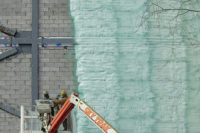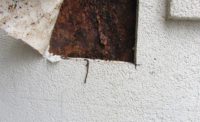In the grand scheme of building materials, Adhered Concrete Masonry Veneer is relatively young. You’ve undoubtedly seen it on beautiful stone exterior façades and extravagant interior details. During the last building boom, it was a material that many trades jumped into and made money installing. However, as with any “jump on board, make money opportunity” the correct training sometimes lags a bit. The plastering trade constructs walls similarly and should consider adding ACMV to their services. Other trades now have access to some great training materials put out by the industry, therefore helping newcomers get up to speed.
SIMILARTIES OF MANUFACTURED STONE & STUCCO
With wall preparation (for typical framed construction, whether wood framing or metal studs/sheathing) the construction of the wall is almost identical to that found on a hard-coat stucco wall. In fact, many of the surface preparation requirements, weather barrier references, flashing of the cladding and jointing, are extracted from the stucco standards (ASTM C-926 and ASTM C-1063). Yet, the methods these ASTM’s are referenced/applied vary from ACMV manufacturer-to-manufacturer. ACMV manufacturers are beginning to unify through a trade association called the Masonry Veneer Manufacturer’s Association, commonly known as MVMA (www.masonryveneer.org). Within the MVMA, its technical committee has given leadership to a document called “Installation Guidelines for Adhered Concrete Masonry Veneer”; the document can be downloaded for free on the MVMA website and will be referenced throughout this article.
Depending on the type of wall to be built, the materials include weather-resistant barriers, as defined in ASTM D226 Specification for Asphalt-Saturated Organic Felt – Grade D or synthetic WRBs, meeting that same standard. The specification may also call reference ASTM E2556 Specification for Vapor Permeable Flexible Sheet Water-Resistive Barriers Intended for Mechanical Attachment. Metal Plaster Bases (expanded metal lath-ASTM C-847, welded wire ASTM C-1032 or woven wire ASTM C-932) provide the base for the scratch-coat of mortar (i.e. stucco) to be embedded; to fully encapsulate the metal plaster base in the scratch coat. In order to accomplish this embedment, the metal base must be “furred” away from the solid substrate 1/4 inch. This is simply accomplished by utilizing “self-furred” galvanized lath that embosses “dimples” or “V-grooves” into the face of the lath sheet to fur the lath 1/4 inch off the surface. Now, the scratch-coat can be troweled through the metal base and fully embed the metal. Some welded wire and woven wire laths include the self-furring into their manufacturing process; verify with the specific wire lath manufacturer. The “embedment” process in the scratch-coat is critical to the long-term performance of both ACMV and hard-coat stucco.
The flashing locations and materials are referenced in the building codes. They may be comprised of galvanized steel, zinc alloy, stainless steel, PVC or asphalt-impregnated copper, aluminum, and self-adhered. Material selection is a function of climatic conditions, the areas of application consideration of dissimilar metals that will have contact. It’s important the flashing/drainage is incorporated into framed wall construction in locations like foundation base (using a FHA#7 – foundation weep screed), above doors/windows (flashing with drip-edge or a drip cap), roof-to-wall transitions, kick-out flashing, sill-pans, floor-to-floor framing on multi-story construction. Flashings are expounded in the MVMA Guidelines, which also lists excellent wall details of applying flashings properly in both design and construction.
WHERE THE SYSTEMS ARE VERY DIFFERENT
Blending and fitting the combination of many shapes, colors and textures of ACMV will require some planning and an eye for design. The best way to learn this skill is to practice and take time to lay material out on the ground before installation. Blending dark colors next to light, heavy textures next to smooth and large stones next to small will provide a good blend. Working out of multiple boxes of material is also important so you understand the complete pallet you have to work from. Take time to fit shapes that minimize joint spaces and don’t require cutting. When you do cut ACMV, try to choose methods that don’t stick out. For example, square or rectangle stones look better with straight cuts. But irregular shaped stones fair better with “hatchet” cuts. And finally, turning cut edges away from the high traffic viewing path (i.e. doorway) improves aesthetics.
Artistic touch: The stones have to be selected and intentionally placed, to create the “look” the owner desires; be it stack stone, rubble, limestone, etc. Furthermore, the mortar placement and tooling add to the stone aesthetics. With stucco, the finish is defined with the aggregate, the trowel, be it sand, mission, dash, etc. In both cases, the installer has the control over the creativity.
Textures, color combinations, and design options: The type of ACMV produced (i.e. boulders, limestone, stack-stone, etc.) and the inclusion of the mortar color all play into the finished look of stone. With stucco, the textures are defined by the trade with trowel movement and wetting of the finish coat. In both cases, variations add to the customization of each wall built. The possibilities are nearly endless. You can blend multiple ACMV textures on the same wall. You can mix colors or add banding. Blending stone and stucco is a common treatment that provides excellent accent treatment
Joint requirements: Control joint requirements is one area where the stucco contractor might be surprised to learn that ACMV has some properties that appear to make it very forgiving of shrinkage cracking. Where stucco has ASTM requirements for wall area limitations and control joint placement, these are not automatically required for ACMV. An informative paper and subsequent articles have been published on this topic by Herb Nordmeyer (found on MVMA website, www.masonryveneer.org).
TRAINING TOOLS AND INDUSTRY ASSISTANCE
MVMA Installation Guideline Document – created by the MVMA Technical Committee, which is comprised of ACMV manufacturers, lath and mortar manufactures, and other related industry investors. The downloadable guideline can be found at www.masonryveneer.com
Good building practices and building science – There are many building science resources available to help with planning and selecting WRBs, flashing, drainage and detailing. Finding a resource that specializes in your climate is recommended. Speaking with the architect of record on a given project and other contractors in your industry and provide valuable insight.
Industry Standards under development – ASTM C-15.11 has under development a Product Standard and Installation Standard, incorporating many of the materials and practices outlined in the MVMA Design Guidelines Manual. This draft standard practice (WK24263) will provide minimum installation requirements for Adhered Manufactured Stone Masonry Veneer Units (AMSMV). The standard is intended to apply to units manufactured to meet the AMSMV product standard being developed within C15.11 under WK12802. Because ASTM is a consensus-based process, all parties involved in the C-15 committee must agree on the writing and developing of the standards. As a result, these two draft standards have been under development for more than four years and may have about a year left to complete and publish. It’s the author’s belief the building codes are clamoring for these ACMV standards and should implement them as soon as they are complete.
Developments and Advancements – As with all industries, there are developments to help improve performance, save installation labor, reduce cost or add sustainability. Recent to the ACMV industry are: methods of installation providing a rain screen or designed drainage cavity behind the veneer, improvements in mortar materials, applications direct to cement board, insulated concrete forms and continuous insulation meeting Federal Energy Standards. The MVMA Technical Committee considers all these changes and ways to address them, when appropriate, in the MVMA Installation Guidelines.
AREAS TO FOCUS ON
Focus on the prep work – Where WRBs are required always use two layers applied as separate layers. Proper lath embedment into mortar is critical and self-furred lath is helpful way to achieve it. Lap the lath sheets/rolls properly and wrap corners completely. Setting ACMV units in a full setting bed is essential. Think of ACMV as the third coat in a hard coat stucco system. The ACMV units and setting bed should be a layer, not blobs of mortar and stone. Use the lath accessories that are designed to help terminate the system, transition materials
Understand your water management strategy – Select the right WRBs for your climate. Understand the strategy to manage and moisture vapor that may get into the wall. Which directions will the wall dry and are there materials in that path that impede vapor movement? Consider a rain screen installation in harsh climates or where code dictates. Flash and drain water at the first possible location. Don’t create areas for water to be damned when it should escape. Minimize water penetration by using soft joints at materials transitions. Provide suitable overhang of caps and drip treatment at material transitions
Know your mortar and use it correctly – Select the correct mortar for your project and mix it per the manufactures instructions. Follow provisions for hot and cold temperature applications. Always use enough mortar to completely encapsulate lath, provide a complete setting bed for the ACMV units and fill mortar joints. The recommendations here are exactly the same as for hard-coat stucco.
Some places where you just shouldn’t use manufactured stone – To or below grade applications look realistic, but can lead to poor performance. Consult the MVMA Installation Guide for recommended clearances. Do not install ACMV as stair treads and risers/kick plate. These applications rarely provide appropriate clearance, required drainage and are often exposed to de-icing chemicals. Most concrete products do not perform well when exposed to de-icing chemicals (mortar or stucco accelerators) and ACMV is one of them. The chemical may cause the metal (lath, trims, flashing, etc.) to rust quickly.
NOW INSTALL SOME STONE
While ACMV is different material as a “finish,” the fundamental assembly of the two walls is very much the same. Both require weather barriers, flashing/drainage, metal plaster bases (lath), scratch-coats, and sealants. Take the time to research the materials and the current industry trade association installation guidelines provided by Masonry Veneer Manufacturers Association, available at www.masonryveneer.org. Plan your project carefully, select quality materials and install them per the industry guidelines and soon you will have a new arrow in your quiver to help your business grow. W&C










![WC0422-FEAT-ClarkDietrich-p1FT-CJ-EES[1].jpg WC0422-FEAT-ClarkDietrich-p1FT-CJ-EES[1].jpg](https://www.wconline.com/ext/resources/2022/04/12/WC0422-FEAT-ClarkDietrich-p1FT-CJ-EES%5b1%5d.jpg?height=200&t=1649794590&width=200)
